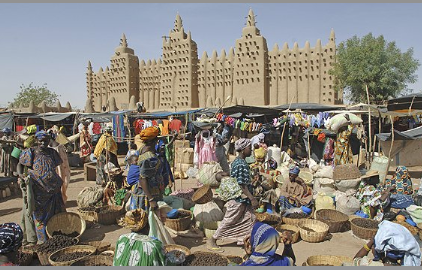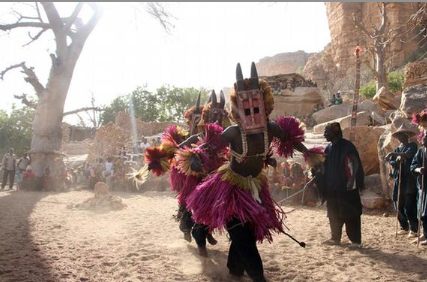Music stars
Despite its political travails, Mali is renowned worldwide
for having produced some of the stars of African music, most
notably Salif Keita. The annual Festival in the Desert has
traditionally celebrated this talent.

The Great Mosque of Djenne is the largest mud brick
building in the world and is a UNESCO-designated
World Heritage Site.
by Elisabcn
Happily Dogon people have managed to preserve many of
their traditional ways, including their mud brick
houses, the shaggy roofed-granaries, the tiny markets
under the wooden and straw roofs and some ceremonial
dances. Nowadays the best way to visit
the Dogon country is walking from one village (picture
1) to another. Along the way you can admire mud mosques,
beautiful landscapes and have a rest in the shade of
baobabs. Other particular constructions that we found
were a pharmacy where each hole is used to contain a
different medecine and a Christian church (!) They like
a lot the wooden details (and they are very nice!) that
decorate their windows, doors, stairs or pillars . The
baobabs and some cultivated fields between the villages
complete the painting. Good panoramas, nice people and,
at night, a fabulous 360-degree celestial view less
[-]
This is Dogon country, which tradition and tourism
once made the most popular attraction for visitors
to Mali.
The dance begins with elders dressed in flowing
indigo robes drumming and singing out over the
sprawling plains below. Thirty dancers appear from
between the rocks wearing heavy wooden masks and
brightly dyed grass skirts. Each represents a
different aspect of Dogon culture - the horned mask
of the bull, a snake mask that towers twice the
height of the dancer himself. Two men on stilts
strut and flap like birds in flight. Furious dancing
kicks dust into the air.
"The masks represent the spirit of man and the
emblem of Mali, whilat the same time the creation of
the world. We organize this dance for celebrations,
for funerals, or when there are ceremonies like
this, but we can only do this once a year," Atime
Sai, the dance organizer, tells DW. "This dance is
known around the world. Sometimes when there were
tourists here we would perform every day. That was
normal. "
The mask dance represents different aspects of Dogon
culture.

BANDIGARA FALL
After leaving the busy cities of Mali, the Bandigara
Fall is an excellent place to forget the world for a
while and do some nice trekkings. This landscape of
cliffs and sandy plateaux (picture 1) is very
interesting from many points of view: geological,
ethnological, archaeological, naturalistic . . . It is
very impressing. There are also some cultivations and
women irrigate them with empty (well full of water)
pumpkins, still following the traditional techniques .
Bandigara Fall is also the land of Dogons, grouped in
different villages and settlements.
DJENNE
Djenné is situated on the shore of Bani River so you
need a ferry to reach it. Djenné is probably the most
ancient and most impressive city in all West Africa.
Placed on a little hill, it's also known as the "Niger's
Venice" (keeping the distances,
of course :D) because during rainy season it is all
surrounded by the water. Djenné was founded in the XI th
century and has always been a very important commercial
point between the sabanah and the desert. You can find
there a nice blend of different ethnic groups too. All
Djenné is built with mud from the Niger River and it's
considered "protected city" and World Heritage by Unesco.
All Djenné is very interesting: wandering around it is
like going back 50years in time! The main spots are its
giant Mosque and the big and colorful market (on
Monday!) just in front of the mosque.Djenné was
definitely the jewel of my trip to Mali!
SEGOU: WALK ALONG THE NIGER RIVER
SHORE
If you
walk along the Niger River shore in Segou you never will
be bored! It’s like a film of popular traditions and
funny street scenes. Apart from the busy port you will
be able to see potters and craftsmen, people working on
the cultivations
and
women using the Niger's waters to wash the dishes and
the clothes (picture 1). And you won't be alone either
because kids as soon as they see a ”tubabu” (white
person) will come to you to greet you with their smiles.
All of them loved our cameras and were happy to be
"models for one day" (picture 2); There was a little boy
that went with me during all the walking holding my hand
and waiting for me patiently every time I stopped (that
means every five minutes : to take a picture to hold my
hand again; What a cute Cicerone! At the end it was hard
to say good
BAMAKO: THE CAPITAL
Bamako
is the capital of Mali and the busiest and richest city
in the country. Situated on the shore of Niger River, it
was founded in 1650. If you visit this city you'll find
a pleasant blend of colonial buildings and busy African
markets. It is
the terminal of the train that arrives from
Dakar too.Bamako is full
of life! It's nice to visit its markets, the craft
center (nice wooden sculptures to buy and lots of
souvenirs), the national museum and the "point G", which
is the viewpoint of the city. Bamako is interesting
for its nightlife and live music too, with lots of pubs
and terrac
DJENNE'S MARKET
I've
visited different markets in Morocco, Tunisia, Peru' . .
. the big market of Samarkand, the grand bazaar in
Istambul . . . but nothing can be compared to Djenné's
Market.The grand marché of Djenné is a real sight of
colors, life and
activities! It's a good place to see all the different
ethnic groups in Mali as well: Peuls, Bozos, Bambaras,
Malinkes, Markas, Rimaïbes . . . ,wearing traditional
dresses and speaking different languages, that come to
the market from different points of the country to sell,
buy and exchange their products. It's too crowded,
smells are very strong and the temperature is always
high so be careful because it's easy to feel sick . . .
The market is situated in front and all around the big
Mosque. You can take good pictures of it from the roofs
of the houses. Every Monday
TOMBOUCTOU
A
thousand-year-old and mythical city. Its name comes from
the guardian "Buctú" that watched over the well "Tim"
that was situated in that area. The city was built
around this well and was
named Timbuktu. Founded during the XIII th century and
now in decadence, it was
the old location of Touareg people. It was an important
Islamic center in the middle of the desert too. During
its bests times it had 25.000 inhabitants, it was
crossed by caravans and people from lots of different
places that came there to do business. In Timbouctou you
will find some interesting places to visit:-the Ahmed
Babá center, where some experts classify and restore
manuscripts in Arabic from the XIV th and XV th
centuries -some mosques-the old university-the museum
and the market-the house of
the first European
explorer, Major Laing . It is a mythical city and so on.




